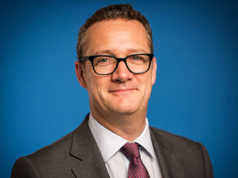 Bert van Meurs is the chief business leader for Image Guided Therapy within Royal Philips, the multinational medical technology company, which offers a portfolio of devices comprising interventional imaging systems, smart catheters, planning and navigation software. In this interview, van Meurs tells Cardiovascular News Philips’ strategy for addressing challenges in the cath lab and future areas for innovation, including Fiber Optic RealShape (FORS) technology.
Bert van Meurs is the chief business leader for Image Guided Therapy within Royal Philips, the multinational medical technology company, which offers a portfolio of devices comprising interventional imaging systems, smart catheters, planning and navigation software. In this interview, van Meurs tells Cardiovascular News Philips’ strategy for addressing challenges in the cath lab and future areas for innovation, including Fiber Optic RealShape (FORS) technology.
Improving outcomes, lowering costs, and improving staff and patient experience are the “quadruple aims” sitting at the heart of Philips’ healthcare business strategy. According to van Meurs, these aims are in tune with many of the challenges faced within interventional cardiology today. As an example of this strategy in practice, he offers recent updates to the company’s flagship cath lab platform Azurion, which now incorporates imaging control, physiology, haemodynamic and informatics applications, among other functionalities. “Rather than focusing on that single modality to see how we can help to provide efficiency, we look horizontally at overall efficiency for these procedures,” Van Meurs tells Cardiovascular News.
However, Van Meurs notes that while Azurion is ostensibly an X-ray-based technology, in future, cath lab procedures are likely to move in a direction that will eliminate the need for the exposure to radiation. “That is where we potentially integrate imaging sources like ultrasound and new technologies like FORS that we have in vascular surgery, that enables a device to image itself without any X-ray,” he says. “That [FORS] is still a nascent technology, but it shows the vision over time if we address these challenges, we should not focus purely on optimising one single modality, but looking at the entire procedure.”
FORS was first introduced into clinical practice in 2018, and has been used in more than 200 cases predominantly involving aortic and peripheral procedures. The technology enables real-time 3D visualisation of the full shape of devices inside the body without the need for fluoroscopy, using light rather than X-ray. Van Meurs acknowledges that the technology has great potential, including possibly in coronary procedures, though he admits that it remains in its infancy.
“In the future, I believe we should eliminate radiation, maybe this will not happen in my generation, but I think my grandson’s generation will not believe that we used X-rays for these procedures!” Van Meurs comments. “I think that will happen, and if you have that vision then you need to invest in technologies that will take you there. FORS, we strongly believe, is that kind of technology.”
At present, the use of FORS is being studied in vascular surgery, where it is seen as an exciting emerging technology, but Van Meurs comments that thorough clinical study and proof of medical evidence is needed before this can be adopted more widely. “That is where we are now,” he adds. “As a next step, we will look at other applications, coronary could potentially be one, but it is not yet fully on the radar screen.”
Gathering clinical evidence to back any new technology being brought to market is described as “fundamental” by Van Meurs, who says that Philips is committed to supporting clinical science to assess the scope of its technologies to improve practice. Among the trials that Philips is currently supporting is DEFINE GPS, a multicentre randomised study evaluating the use of instantaneous wave-free ratio (iFR) measurements in combination with Philips’ co-registration system—SyncVision—to enhance percutaneous coronary intervention (PCI) guidance and provide superior treatment outcomes.
“You need to come with two-, three-, or up to five-year outcome data to support the claims that you make, that has become a fundamental part of how we do the innovation,” he comments. “It is essential, these days you cannot make any claim if you do not come with the medical evidence based upon clinical studies.”
Discussing areas where he sees room for innovation in interventional cardiology, Van Meurs notes that the deployment of artificial intelligence (AI) in diagnosis and decision support is likely to be a significant future development.
“There is so much data that is being acquired for a patient along the care pathway, and if you translate that data into valuable information that can help you decide what will be the best protocol for this patient based upon the data of thousands of patients that also had a mitral valve replacement, for example,” he comments.
Robotics is another area in which he sees potential for further development, although he says this will merely be in support of, and not at the expense of the human operator. “If you use robotics as a technology for procedure automation, using imaging as the eyes of the robot, you can navigate more easily. That is where robots will play a role,” he notes, though commenting that, like FORS, these types of developments remain a way away from becoming common practice.
Turning to the near future, Van Meurs previews Philips’s participation at the upcoming Transcatheter Cardiovascular Therapeutics annual meeting (TCT 2021; 4–6 November; Orlando, USA) where he says there will be a focus on how its technologies can integrate to optimise PCI procedures and showcasing devices including the VeriSight Prointracardiac echocardiography catheter.











